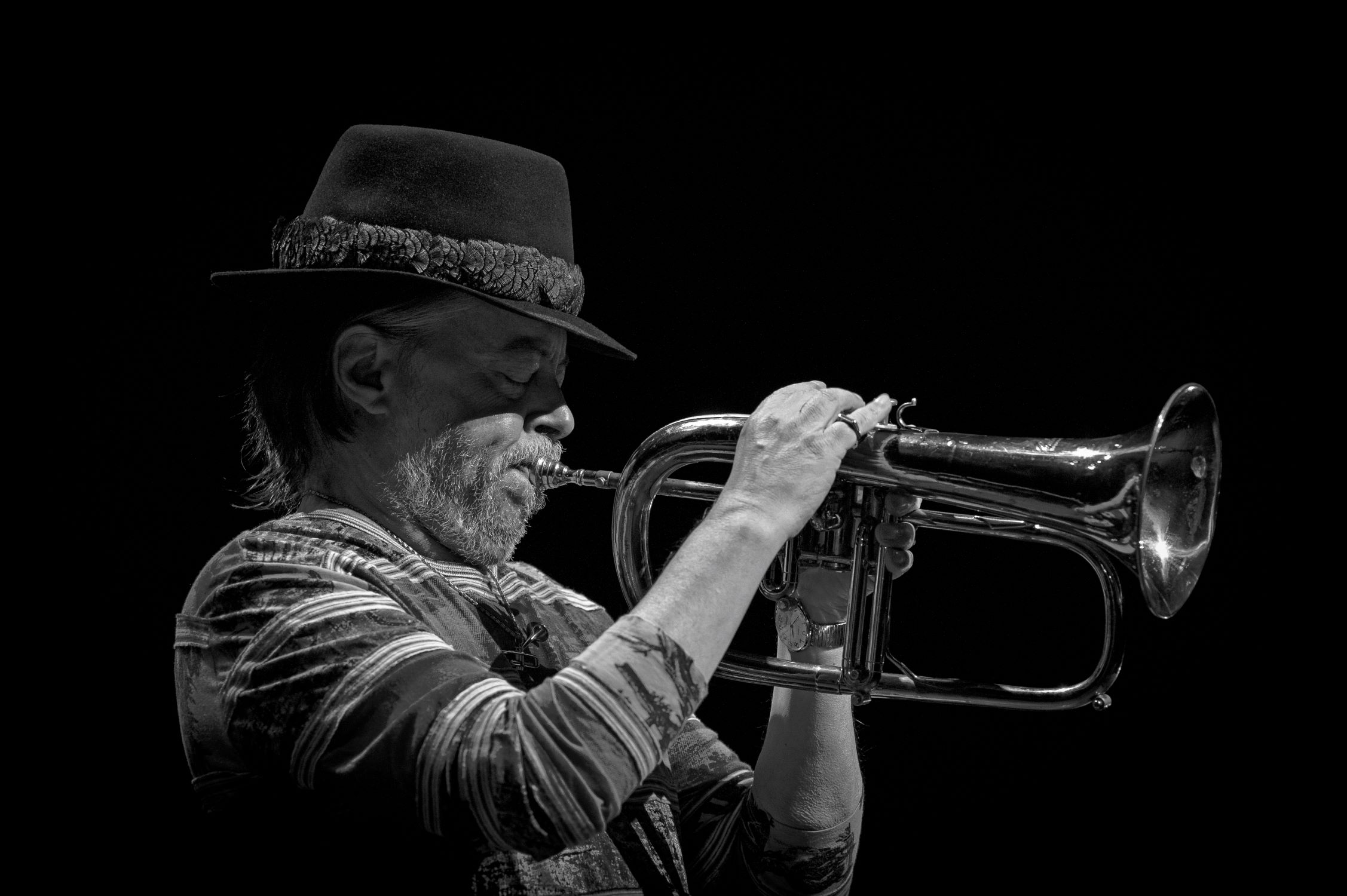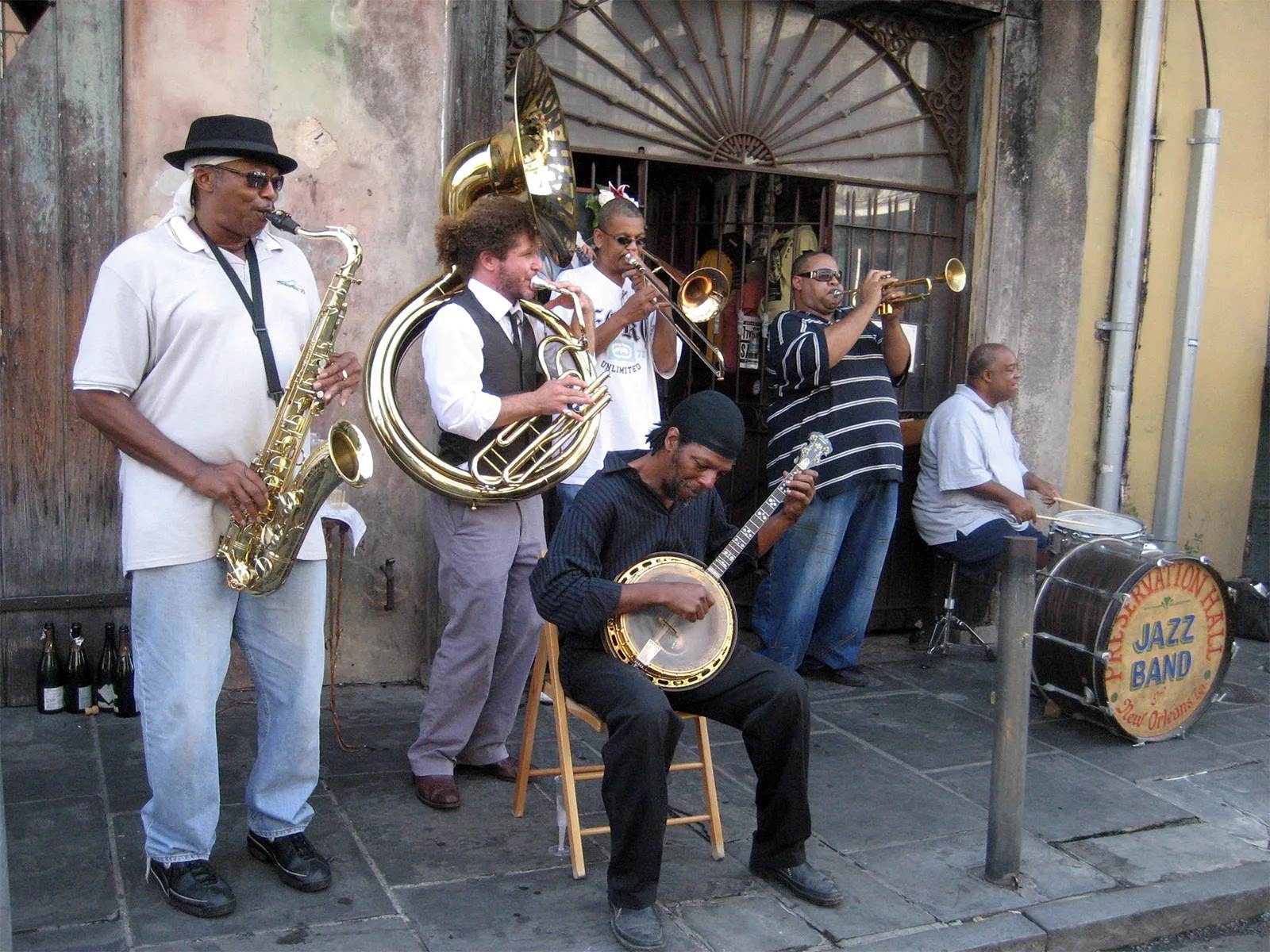

Jazz
What Makes Jazz Music
Modified: January 22, 2024
Discover the unique and captivating world of Jazz music. Immerse yourself in the rich history, rhythmic melodies, and improvisational brilliance of this timeless genre.
(Many of the links in this article redirect to a specific reviewed product. Your purchase of these products through affiliate links helps to generate commission for AudioLover.com, at no extra cost. Learn more)
Table of Contents
Introduction
Jazz music is a genre that has captivated audiences around the world for over a century. With its roots deeply intertwined with African-American culture, jazz has evolved into a complex and diverse form of musical expression. From the smoky clubs of New Orleans to the grand concert halls of New York City, jazz has carved its place in music history as a truly unique and innovative art form.
What sets jazz apart from other genres is its emphasis on improvisation, rhythmic complexity, and individual expression of the musicians. It is a genre that encourages artistic freedom and exploration, allowing for endless variations and interpretations of the music. Jazz is not just a style of music; it is a way of thinking, a language of emotions, and a means of connecting with others on a deeply personal level.
In this article, we will delve into the origins of jazz music, explore its defining characteristics, examine the role of improvisation and rhythm, discuss the various instruments and ensembles used in jazz, highlight the influences of African-American culture, explore different jazz styles and subgenres, and recognize some of the notable jazz musicians who have left a lasting impact on the genre.
Whether you’re a casual listener or a die-hard jazz enthusiast, this article will take you on a journey through the fascinating world of jazz music, shedding light on what makes it such a remarkable and influential genre.
Origins of Jazz Music
Jazz music traces its roots back to the late 19th and early 20th centuries in the African-American communities of the United States, particularly in the city of New Orleans, Louisiana. The merging of African musical traditions, European musical elements, and the unique cultural experiences of African-American slaves gave birth to what is now known as jazz.
One of the key influences on the development of jazz was the African rhythmic and melodic traditions brought to America through the slave trade. These traditions, with their intricate polyrhythms and call-and-response patterns, provided the foundation for the rhythmic complexity that would become a hallmark of jazz music. The European influence came in the form of harmonies, instrumentation, and musical structures, which were then combined with African elements to create a unique and vibrant sound.
New Orleans, with its diverse population and vibrant cultural scene, became a melting pot of musical influences. The city’s bustling streets and lively music clubs provided a fertile ground for the creation and evolution of jazz. It was in New Orleans that the first jazz bands emerged, featuring a combination of brass instruments, stringed instruments, and percussion.
During this time, jazz music was predominantly performed in African-American communities and was heavily influenced by the social and cultural experiences of the musicians. It served as a means of self-expression and a way to communicate their stories and struggles. Jazz quickly gained popularity and began to spread beyond New Orleans, reaching cities like Chicago and New York, where it was embraced by a wider audience.
Notable early jazz musicians such as Louis Armstrong, Jelly Roll Morton, and Sidney Bechet emerged during this period, playing a crucial role in defining the sound and style of jazz. Their innovations in improvisation, soloing, and ensemble playing laid the foundation for the future of the genre.
Overall, the origins of jazz music can be traced back to the vibrant cultural landscape of New Orleans, where various musical traditions and experiences converged. From its humble beginnings, jazz would go on to become one of the most influential and enduring genres in the history of music.
Characteristics of Jazz Music
Jazz music is known for its distinctive characteristics that set it apart from other genres. These unique qualities combine to create a dynamic and captivating sound that resonates with listeners around the world. Let’s explore some of the key characteristics of jazz music:
- Improvisation: One of the defining features of jazz is its emphasis on improvisation. Jazz musicians often take a basic melody or chord progression and spontaneously create new melodies and variations on the spot. This element of improvisation allows for individual expression, creativity, and the ability to adapt and react to the energy of the moment.
- Swing Rhythm: Jazz music is deeply rooted in swing rhythm, which gives it a distinctive groove and energy. Swing rhythm involves a syncopated or “off-beat” feel, with a strong emphasis on the second and fourth beats of a 4/4 time signature. This swinging rhythm creates a sense of propulsion and infectious energy that is synonymous with jazz.
- Syncopation: Another characteristic of jazz music is the use of syncopation. Syncopation is the displacement of accents or rhythmic patterns, typically by placing emphasis on weak beats or off-beat notes. This rhythmic complexity adds an element of surprise and tension, creating a sense of forward momentum and excitement in the music.
- Call and Response: Jazz often incorporates call and response patterns, a musical conversation between different instruments or sections of the band. This technique involves one musician playing a phrase or melody, and another musician or group of musicians responding with a variation or counter-melody. Call and response adds depth, interaction, and improvisational possibilities within the ensemble.
- Harmonic Complexity: Jazz is known for its rich and complex harmonic language. It utilizes chord progressions that go beyond the traditional major and minor scales, incorporating extended chords, altered harmonies, and chord substitutions. This harmonic complexity allows for more expressive and adventurous improvisation by the musicians.
- Variety of Forms: Jazz music encompasses a wide range of forms and structures, from the traditional 12-bar blues to intricate and multi-sectioned compositions. Jazz musicians often explore different song forms such as ballads, blues, swing, bebop, and modal jazz, allowing for a diverse and eclectic musical experience.
These are just a few of the many characteristics that define jazz music. It is this combination of improvisation, swing rhythm, syncopation, call and response, harmonic complexity, and varied forms that gives jazz its distinctive and captivating sound. Whether you’re listening to a swinging big band, a small combo, or a soloist improvising on a melody, the unique qualities of jazz never fail to leave a lasting impression.
Improvisation in Jazz
One of the most fascinating aspects of jazz music is its emphasis on improvisation. Unlike many other genres where the music is meticulously rehearsed and performed exactly as written, jazz musicians thrive on the art of spontaneous creation. Improvisation lies at the heart of jazz, allowing musicians to express their individuality, creativity, and personal interpretation of the music.
In jazz, improvisation involves the creation of new melodies, harmonies, rhythms, and variations on the spot. It is a form of musical conversation between the performers, where ideas are exchanged and developed in real-time. Through improvisation, musicians are able to communicate their emotions, unique musical ideas, and technical prowess to engage with the music and the audience on a deeper level.
The foundation of jazz improvisation is the ability to navigate through chord progressions and scales. Musicians must have a solid understanding of music theory, harmony, and chord structures to craft their improvisations in a meaningful and cohesive way. By carefully selecting and connecting notes that complement the underlying chords, jazz musicians create melodic lines that weave seamlessly into the fabric of the music.
Improvisation in jazz is not simply random or aimless playing. It requires a combination of technical skill, knowledge, and intuition. Musicians draw from their wealth of musical experiences, influences, and practice to inspire their improvisations. They listen attentively to the other musicians in the ensemble, responding and interacting with their playing to create a coherent musical dialogue.
Jazz improvisation is a continual process of exploration and discovery. Each performance is unique, as musicians respond to the energy of the moment and the inspiration flowing through them. It is a form of musical storytelling, where the soloist takes themes or motifs from the melody and develops them, adding their own personal touches and interpretations.
Improvisation is not limited to soloists in jazz; it is also an integral part of ensemble playing. Jazz musicians engage in collective improvisation, where everyone in the band contributes their own ideas and interacts with each other in a spontaneous and cohesive manner. This dynamic interaction creates a sense of excitement, unpredictability, and musical synergy that is a hallmark of jazz performances.
Through improvisation, jazz music stays fresh and vibrant, constantly evolving with each new interpretation. It allows the musicians to push the boundaries of the music and take risks, leading to innovative and groundbreaking performances. Improvisation is not only a technical and artistic skill, but it also embodies the spirit of jazz as a free and expressive art form.
Importance of Rhythm in Jazz
Rhythm plays a vital role in jazz music, serving as the heartbeat and driving force behind its energetic and infectious sound. From the syncopated rhythms of swing to the complex and intricate patterns of bebop, rhythm is a foundational element that shapes the character and feel of jazz music.
In jazz, rhythm is not merely a background element, but an integral part of the music that establishes the groove, swing, and overall sense of momentum. The rhythmic interplay between musicians creates a dynamic and interactive experience for both the performers and the audience.
One of the key rhythmic aspects in jazz is swing rhythm. Swing refers to a specific way of playing eighth notes with a lilt or a “bounce” that gives the music a distinct feel. It involves accenting the off-beats, typically the second and fourth beats in a 4/4 time signature. Swing rhythm creates a sense of forward motion, propelling the music and inviting listeners to tap their feet or bob their heads in sync with the groove.
Jazz musicians also employ syncopation, a technique that involves placing accents or emphasizing weak beats or off-beat notes. Syncopation adds a layer of complexity and tension to the rhythm, creating unexpected rhythmic patterns that add excitement and unpredictability to the music. It allows jazz musicians to push the boundaries of traditional rhythmic structures and explore new rhythmic territories.
Rhythm in jazz is not only expressed through the drums and percussion instruments but also through the melodic instruments like the piano, guitar, brass, and woodwind instruments. The rhythmic phrasing and articulation of these instruments contribute to the overall rhythmic texture of the music.
Furthermore, jazz places great importance on rhythmic improvisation. Musicians are encouraged to experiment with rhythmic patterns, subdivisions, and accents, adding their unique rhythmic ideas and variations to the music. This rhythmic spontaneity and creativity give jazz its sense of liveliness and improvisational freedom.
It is worth mentioning that jazz also draws inspiration from various rhythmic traditions, such as Afro-Cuban and Latin rhythms. The incorporation of these rhythms adds depth and richness to the rhythmic palette of jazz music, creating vibrant and diverse sonic textures.
In essence, rhythm is the lifeblood of jazz music. It provides the structure, drive, and foundation that allow musicians to express themselves, interact with one another, and create a musical experience that is both rhythmically captivating and emotionally resonant. Whether it’s the swinging beat of a big band or the intricate rhythmic patterns of a small ensemble, rhythm is at the core of what makes jazz music truly special.
Jazz Instruments and Ensembles
Jazz music boasts a wide range of instruments and ensembles that contribute to its unique and diverse sound. From brass and woodwind instruments to piano, guitar, and rhythm section instruments, each instrument brings its own character and contributes to the rich tapestry of jazz. Let’s explore some of the key instruments and ensembles commonly found in jazz.
Brass Instruments: Brass instruments play a prominent role in jazz ensembles, bringing a bold and expressive sound. Trumpet, trombone, and saxophone are often featured as solo instruments and participate in melodic improvisations. The trumpet’s piercing sound, the trombone’s smooth slides, and the saxophone’s soulful tones add layers of emotion and excitement to jazz performances.
Woodwind Instruments: Alongside brass instruments, woodwind instruments such as clarinet and flute find their place in jazz ensembles. The clarinet’s agility and the flute’s airy tones provide contrasting timbres and expand the melodic possibilities in jazz compositions and improvisations.
Piano: The piano serves as a versatile and harmonically rich instrument in jazz. Pianists provide both rhythmic and melodic support, comping chords, playing bass lines, and taking expressive solos. The piano’s ability to play multiple notes simultaneously allows for complex harmonic voicings, further enhancing the depth and sophistication of jazz music.
Guitar: The guitar in jazz can take various roles, from playing chords in a rhythm section to providing melodic lines and solos. Guitarists often employ various techniques like comping, strumming, and single-note lines to create a range of textures and enrich the harmonic and rhythmic landscape of jazz music.
Rhythm Section: The rhythm section forms the backbone of a jazz ensemble, providing the foundational groove and support for improvisations. It typically consists of drums, double bass or bass guitar, and sometimes piano or guitar. The drums drive the rhythm, providing accents, fills, and rhythmic variations. The bass establishes the harmonic foundation and adds depth and stability to the music. Together, they create a tight and cohesive rhythmic framework for the other instruments to build upon.
Big Bands: Big bands, also known as jazz orchestras, are larger ensembles that feature multiple sections of brass and woodwind instruments, along with a rhythm section. Big bands became popular during the swing era and are known for their vibrant and powerful sound. They typically include trumpets, trombones, saxophones, piano, guitar, bass, and drums, creating a rich ensemble that allows for intricate arrangements, harmonies, and solo features.
Small Combos: Small jazz ensembles, or combos, typically consist of three to six musicians. These smaller groups provide the opportunity for more intimate and interactive performances, with each musician having a greater role and responsibility in the music-making process. Small combos often feature a combination of a rhythm section with one or more solo instruments, allowing for more improvisation and interplay between the musicians.
These are just a few examples of the diverse range of instruments and ensembles found in jazz music. Whether it’s the soaring melodies of a saxophone, the melodic comping of a piano, or the driving rhythm of a drum set, each instrument and ensemble contributes to the awe-inspiring and ever-evolving world of jazz.
Influences of African-American Culture on Jazz
The roots of jazz music are deeply intertwined with African-American culture, as it emerged and flourished within African-American communities in the early 20th century. The influences of African-American culture on jazz are profound and can be seen in various aspects of the music. Let’s explore some of the key ways in which African-American culture has shaped jazz:
Rhythmic Traditions: African music has a long-standing tradition of complex rhythms and polyrhythms, characterized by intricate patterns and interlocking beats. These rhythmic traditions found their way into jazz, forming the foundation of its rhythmic complexity and syncopated groove. The emphasis on swing rhythm, syncopation, and intricate drumming patterns can be directly traced back to African rhythmic influences.
Call and Response: Call and response is a musical practice deeply rooted in African cultural traditions. It involves a musical dialogue between a lead singer or musician and a group or an audience. Call and response was assimilated into jazz, resulting in the improvisational conversation between soloists and the ensemble, where a soloist presents a musical idea and receives a response from other musicians. This element of interaction and exchange is a key characteristic of jazz performances.
Oral Tradition and Storytelling: African cultures have a strong tradition of oral storytelling and musical expression as a means of passing down history, folklore, and cultural values. Jazz musicians, particularly through their improvisations, evoke this oral tradition by telling stories and conveying emotions through their musical performances. The ability to express oneself spontaneously and emotionally is deeply rooted in the African-American cultural heritage.
Spirituals and Gospel Music: African-American religious music, such as spirituals and gospel, has greatly influenced jazz. Spirituals, rooted in the experiences of slavery, express hope, endurance, and liberation through music. Gospel music, with its vibrant call and response singing, emotive melodies, and powerful vocal performances, inspired the soulful and bluesy elements of jazz. The deep spirituality and emotional intensity found in spirituals and gospel music continue to resonate in jazz compositions and performances.
Expressive Techniques and Vocalizations: African-American vocal traditions, including moans, shouts, vocal improvisations, and expressive techniques like vibrato and glissando, have had a significant impact on jazz music. Jazz vocalists often incorporate these techniques into their performances, adding a distinct flavor and emotional depth to their interpretations.
Blues Influence: The blues, which originated within African-American communities, influenced the harmonic language, melodic expressions, and emotional depth of jazz. The incorporation of blues scales, blue notes, and the structure of blues progressions provided a foundation for jazz improvisation and added a poignant and soulful element to the music.
The African-American cultural contributions to jazz are immeasurable, shaping not only the music itself but also the cultural identity and significance of the genre. Jazz, as an art form born out of the experiences of African-Americans, continues to embody the spirit of resilience, creativity, and creative expression that is deeply rooted in African-American culture.
Jazz Styles and Subgenres
Jazz is a genre known for its diversity and constant evolution. Throughout its history, jazz has given rise to numerous styles and subgenres, each with its own unique characteristics and influences. Let’s explore some of the main jazz styles and subgenres:
1. Swing: Swing emerged in the 1930s as the dominant style of jazz and remains one of the most popular. It is characterized by its strong rhythm and emphasis on the off-beats, creating a sense of propulsive and infectious swing. Big band jazz, with its brass and woodwind sections, is closely associated with swing.
2. Bebop: Bebop, also known as “bop,” emerged in the 1940s as a response to the constraints and limitations of swing. It is characterized by its fast tempo, complex harmonies, and intricate improvisation. Bebop musicians, such as Charlie Parker and Dizzy Gillespie, expanded the range of jazz through their virtuosic playing and innovative harmonic language.
3. Cool Jazz: Cool jazz emerged in the 1950s as a reaction against the intensity and complexity of bebop. It favors a more relaxed and laid-back sound, incorporating elements of classical music and a focus on composition and arrangement. Artists like Miles Davis and Chet Baker are associated with the cool jazz movement.
4. Hard Bop: Hard bop, also known as “funky jazz,” developed in the 1950s and 1960s as a fusion of bebop, blues, and R&B. It emphasizes a strong rhythm section, soulful melodies, and a raw and energetic approach to improvisation. Hard bop musicians, including Art Blakey and Horace Silver, brought a new intensity and earthiness to their music.
5. Modal Jazz: Modal jazz gained popularity in the late 1950s and early 1960s with the work of musicians such as Miles Davis and John Coltrane. It focuses on improvisation over a limited set of scales or modes rather than traditional chord progressions. Modal jazz is characterized by its atmospheric, meditative, and exploratory nature.
6. Fusion: Fusion emerged in the 1960s and 1970s as a fusion of jazz with other genres, such as rock, funk, and electronic music. It incorporates elements of improvisation, complex harmonies, and a greater emphasis on electric instruments and experimentation. Artists like Herbie Hancock and Weather Report pushed the boundaries of traditional jazz with their fusion compositions.
7. Latin Jazz: Latin jazz blends traditional jazz with Latin American rhythms and instrumentation. It incorporates elements of Afro-Cuban, Brazilian, and other Latin styles, adding a fiery and rhythmic flavor to the music. Artists like Tito Puente and Machito popularized Latin jazz, creating a dynamic fusion of cultures.
8. Contemporary Jazz: Contemporary jazz refers to more recent developments in the genre, encompassing a wide range of styles and approaches. It features a blend of traditional jazz elements with influences from other genres, such as hip-hop, R&B, and world music. Contemporary jazz artists continually push boundaries, experimenting with new sounds and incorporating modern production techniques.
This is just a glimpse into the vast array of jazz styles and subgenres that have emerged over the years. Each style reflects the cultural, social, and artistic influences of its time, showcasing the ever-evolving nature of jazz as an art form.
Notable Jazz Musicians
Jazz has been blessed with an abundance of remarkable and influential musicians throughout its history. These artists have left an indelible mark on the genre, pushing the boundaries of musical expression and setting new standards for creativity and innovation. Here are some notable jazz musicians who have made significant contributions to the world of jazz:
1. Louis Armstrong: A true jazz legend, Louis Armstrong was a trumpeter, vocalist, and bandleader whose distinctive voice and virtuosic trumpet playing revolutionized jazz. His innovative improvisations, infectious personality, and influential recordings established him as one of the most important figures in jazz history.
2. Duke Ellington: Duke Ellington was a prolific composer, pianist, and bandleader, renowned for his sophisticated and innovative compositions and arrangements. His orchestra, the Duke Ellington Orchestra, showcased the talents of renowned musicians and played a pivotal role in the development of big band jazz.
3. Charlie Parker: Known as “Bird,” Charlie Parker was a saxophonist and composer who played a pivotal role in the development of bebop. His rapid, virtuosic playing and complex improvisations revolutionized jazz and had a profound influence on subsequent generations of musicians.
4. Ella Fitzgerald: Ella Fitzgerald, also known as the “First Lady of Song,” was a jazz vocalist with an unparalleled vocal range, unparalleled technique, and breathtaking improvisational skills. Her impeccable phrasing, scat singing, and ability to bring emotion into every performance made her one of the greatest jazz singers of all time.
5. Miles Davis: Miles Davis was a visionary trumpeter, bandleader, and composer who consistently pushed the boundaries of jazz and embraced new directions and styles. From bebop to cool jazz, modal jazz to fusion, Davis’s innovative spirit and willingness to experiment made him a vanguard of jazz evolution.
6. John Coltrane: John Coltrane was a saxophonist and composer who expanded the possibilities of jazz improvisation and composition. His innovative playing techniques, his exploration of complex chords and scales, and his spiritual approach to music left a lasting impact and cemented him as one of the most iconic figures in jazz.
7. Billie Holiday: Billie Holiday, often referred to as “Lady Day,” was a jazz vocalist known for her unique voice, emotional depth, and storytelling ability. Her interpretations of jazz standards and poignant renditions of blues songs touched the hearts of millions and left an unforgettable imprint on vocal jazz.
8. Thelonious Monk: Thelonious Monk was a pianist and composer known for his avant-garde approach to jazz. His unconventional harmonies, dissonant chords, and angular melodies brought a fresh perspective to the genre, making him a true iconoclast of jazz.
These are just a few of the countless jazz musicians who have made significant contributions to the genre. Each artist mentioned here, along with many others, has helped shape the evolution and artistic richness of jazz, leaving a lasting legacy and inspiring generations of musicians to come.
Impact and Legacy of Jazz Music
Jazz music has had an immeasurable impact on the world of music, culture, and society. From its humble beginnings in African-American communities to its global influence, jazz has left an indelible mark on the artistic landscape. Here are some of the key ways in which jazz has made a lasting impact:
Musical Innovation: Jazz has been at the forefront of musical innovation throughout its history. It has pushed the boundaries of harmony, rhythm, and improvisation, inspiring countless musicians to explore new sounds and techniques. The innovations in jazz have not only influenced the genre itself but also had a profound impact on other genres such as rock, pop, and classical music.
Cultural Bridge: Jazz has served as a bridge that brings people together across different cultures and backgrounds. It has transcended racial and social boundaries, providing a platform for mutual understanding and appreciation. Jazz’s ability to fuse diverse musical traditions and its emphasis on collaborative improvisation reflects the spirit of cultural exchange and openness.
Social and Political Commentary: Jazz has often been used as a medium for social and political commentary. Through its expressive and improvisatory nature, jazz musicians have addressed issues of racial inequality, social injustice, and civil rights. Jazz has served as a voice for marginalized communities, shedding light on the challenges they face and advocating for social change.
Educational Value: Jazz has played a vital role in music education, teaching students about improvisation, harmony, and rhythmic complexity. It has been integrated into academic curricula and serves as a foundation for music theory and performance. Jazz education programs and workshops provide opportunities for young musicians to learn from experienced artists, ensuring the continuation of the jazz tradition.
Revitalization of Traditional Music: Jazz has played a crucial role in revitalizing and preserving traditional African-American music forms such as the blues, spirituals, and ragtime. Jazz musicians have drawn inspiration from these musical traditions and incorporated them into their compositions, ensuring their longevity and cultural significance.
Global Cultural Influence: Jazz has become a universal language, transcending borders and influencing musicians and artists worldwide. Its impact can be seen in the emergence of jazz scenes and festivals in various countries, as well as the incorporation of jazz elements into diverse music genres around the world.
The legacy of jazz continues to thrive and evolve. It remains an expressive and dynamic art form, constantly reinventing itself while honoring its rich heritage. Jazz’s impact extends far beyond the realm of music, serving as a testament to the power of creativity, collaboration, and cultural expression. As we look to the future, jazz will continue to inspire and shape the musical landscape, reminding us of the enduring power of this extraordinary genre.
Conclusion
Jazz music, with its rich history, diverse styles, and innovative spirit, holds a special place in the world of music. From its roots in African-American communities to its global influence, jazz has captivated audiences and musicians alike for over a century. Its unique characteristics, such as improvisation, syncopation, and swing, set it apart from other genres and make it a truly remarkable art form.
Throughout its evolution, jazz has been a reflection of the times, incorporating cultural, social, and political influences. It has served as a form of creative expression, a means of storytelling, and a platform for social commentary. The impact of jazz reaches beyond the confines of music, influencing art, fashion, literature, and societal norms.
Jazz has nurtured and produced countless virtuosic musicians who have become legends in their own right. From Louis Armstrong and Duke Ellington to Miles Davis and Ella Fitzgerald, their contributions have shaped the course of jazz and inspired generations of musicians to push the boundaries of their own creativity.
Moreover, jazz has proven to be a powerful bridge, transcending boundaries of race, culture, and geography. Its universal language brings people together and fosters understanding and acceptance. Jazz’s ability to blend different musical traditions and embrace cultural diversity has made it a symbol of unity and collaboration.
As we celebrate and appreciate the legacy of jazz, it is crucial to recognize its educational value. Jazz education programs and initiatives ensure that the art form continues to thrive, passing on the knowledge and techniques to future generations of musicians. These programs cultivate appreciation for improvisation, encourage critical thinking, and foster a love for the rich cultural heritage of jazz.
In conclusion, jazz music is a force that has left an enduring impact on the world. Its rhythm, improvisation, and melodic expressions continue to captivate audiences and inspire musicians from all corners of the globe. Jazz’s ability to evolve, adapt, and reflect the times ensures its relevance and influence in the years to come. Whether you’re a casual listener or a devoted fan, the vibrant world of jazz offers a never-ending journey of discovery and appreciation for the beauty and complexity of this extraordinary musical genre.











